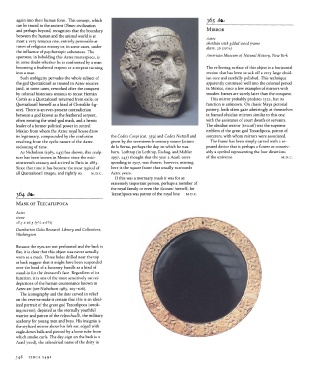Page 549 - Art In The Age Of Exploration (Great Section on Chinese Art Ming Dynasty)
P. 549
again into their human form. This concept, which 365
can be traced to the ancient Olmec civilization
and perhaps beyond, recognizes that the boundary MIRROR
between the human and the animal world is at Aztec
most a very tenuous one, entirely permeable at obsidian with gilded wood frame
times of religious ecstasy or, in some cases, under diam. 26 fio^A)
the influence of psychotropic substances. The
spectator, in beholding this Aztec masterpiece, is American Museum of Natural History, New York
in some doubt whether he is confronted by a man
becoming a feathered serpent or a serpent turning The reflecting surface of this object is a horizontal
into a man. section that has been struck off a very large obsid-
Such ambiguity pervades the whole subject of ian core and carefully polished. This technique
the god Quetzalcoatl as treated in Aztec sources apparently continued well into the colonial period
(and, in some cases, reworked after the conquest in Mexico, since a few examples of mirrors with
by colonial historians anxious to recast Hernan wooden frames are surely later than the conquest.
Cortes as a Quetzalcoatl returned from exile, or This mirror probably predates 1521, but its
Quetzalcoatl himself as a kind of Christlike fig- function is unknown. On classic Maya pictorial
ure). There is an ever-present contradiction pottery, lords often gaze admiringly at themselves
between a god known as the feathered serpent, in framed obsidian mirrors similar to this one,
often wearing the wind-god mask, and a heroic with the assistance of court dwarfs or servants.
leader of a former political power in central The obsidian mirror (tezcatl) was the supreme
Mexico from whom the Aztec royal house drew emblem of the great god Tezcatlipoca, patron of
its legitimacy, compounded by the confusion the Codex Cospi (cat. 359) and Codex Nuttall and sorcerers, with whom mirrors were associated.
resulting from the cyclic nature of the Aztec given by the seventeenth-century source Jacinto The frame has been simply carved with a re-
reckoning of time. de la Serna, perhaps the day on which he was peated device that is perhaps a flower or conceiv-
As Nicholson (1983,143) has shown, this sculp- born. Lothrop (in Lothrop, Foshag, and Mahler ably a symbol representing the four directions
ture has been known in Mexico since the mid- 1957, 243) thought that the year 2 Acatl, corre- of the universe. M.D.C.
nineteenth century and arrived in Paris in 1883. sponding to 1507, was shown; however, missing
Since that time it has become the most typical of here is the square frame that usually surrounds
all Quetzalcoatl images, and rightly so. M.D.C. Aztec years.
If this was a mortuary mask it was for an
extremely important person, perhaps a member of
the royal family or even the tlatoani himself, for
364 Tezcatlipoca was patron of the royal line. M.D. c.
MASK OF TEZCATLIPOCA
Aztec
stone
l
3
18.5 x 16.3 (7 /4 x 6 / 8)
Dumbarton Oaks Research Library and Collections,
Washington
Because the eyes are not perforated and the back is
flat, it is clear that this object was never actually
worn as a mask. Three holes drilled near the top
at back suggest that it might have been suspended
over the head of a funerary bundle as a kind of
stand-in for the deceased's face. Regardless of its
function, it is one of the most sensitively carved
depictions of the human countenance known in
Aztec art (see Nicholson 1983, 105-106).
The iconography and the date carved in relief
on the reverse make it certain that this is an ideal-
ized portrait of the great god Tezcatlipoca (smok-
ing mirror), depicted as the eternally youthful
warrior and patron of the telpochcalli, the military
academy for young men and boys. His insignia is
the stylized mirror above his left ear, edged with
eagle-down balls and pierced by a bone tube from
which smoke curls. The day- sign on the back is 2
Acatl (reed), the calendrical name of the deity in
548 CIRCA 1492

